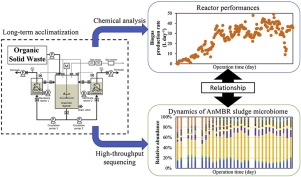当前位置:
X-MOL 学术
›
Biochem. Eng. J.
›
论文详情
Our official English website, www.x-mol.net, welcomes your
feedback! (Note: you will need to create a separate account there.)
Long-term acclimatization of sludge microbiome for treatment of high-strength organic solid waste in anaerobic membrane bioreactor
Biochemical Engineering Journal ( IF 3.7 ) Pub Date : 2020-02-01 , DOI: 10.1016/j.bej.2019.107461 Tomohiro Inaba , Tomo Aoyagi , Tomoyuki Hori , Amine Charfi , Changwon Suh , Jong Hoon Lee , Yuya Sato , Atsushi Ogata , Hidenobu Aizawa , Hiroshi Habe
Biochemical Engineering Journal ( IF 3.7 ) Pub Date : 2020-02-01 , DOI: 10.1016/j.bej.2019.107461 Tomohiro Inaba , Tomo Aoyagi , Tomoyuki Hori , Amine Charfi , Changwon Suh , Jong Hoon Lee , Yuya Sato , Atsushi Ogata , Hidenobu Aizawa , Hiroshi Habe

|
Abstract In this study, anaerobic membrane bioreactor (AnMBR) was applied for the treatment of a model slurry of high-strength organic solid waste. Continuous monitoring of reactor performances by chemical analyses and fine-scale tracing of the AnMBR sludge microbiome by high-throughput 16S rRNA gene sequencing were conducted during the long-term operation with increased organic loading rates (OLRs) up to 5.26 kgCOD m−3 day−1. Stable treatment was achieved at the highest OLR for over 170 days. The chemical oxygen demand removal rate of around 99%, membrane flux of 3.31 ± 0.40 L m−2 h−1, and biogas production rate of 31.1 ± 4.8 L day−1 were observed. The latter two parameters were improved after the sludge retention time (SRT) control, showing 4.76 ± 0.25 L m−2 h−1 and 34.5 ± 6.9 L day−1, respectively. The principal coordinate and taxonomic analyses of the sequence data showed that the sludge microbiome was changed drastically in response to both the OLR increase and SRT control. The species-level characterization showed that the relative abundances of aceticlastic methanogens, e.g., Methanosaeta concilii, decreased at high OLRs, whereas those of hydrogenotrophic methanogens, such as Methanolinea mesophila, as well as a syntrophic bacterium Smithella propionica, increased under the high OLRs and SRT control conditions. These results strongly suggest that the effective treatment of the high-strength organic solid waste slurry was mediated via the syntrophic methanogenesis pathway in the AnMBR.
中文翻译:

污泥微生物群长期驯化处理厌氧膜生物反应器高强度有机固体废物
摘要 本研究采用厌氧膜生物反应器(AnMBR)处理高强度有机固体废物模型泥浆。在长期运行期间,通过化学分析连续监测反应器性能,并通过高通量 16S rRNA 基因测序对 AnMBR 污泥微生物组进行精细追踪,有机负荷率 (OLR) 增加至 5.26 kgCOD m-3 天-1。在超过 170 天的最高 OLR 下实现了稳定处理。观察到化学需氧量去除率约为 99%,膜通量为 3.31 ± 0.40 L m-2 h-1,沼气产量为 31.1 ± 4.8 L day-1。后两个参数在污泥滞留时间 (SRT) 控制后得到改善,分别显示 4.76 ± 0.25 L m-2 h-1 和 34.5 ± 6.9 L day-1。序列数据的主要坐标和分类学分析表明,污泥微生物组因 OLR 增加和 SRT 控制而发生了巨大变化。物种水平表征表明,乙酸产甲烷菌(例如 Methanosaeta concilii)的相对丰度在高 OLR 下降低,而氢营养型产甲烷菌(例如中嗜甲烷甲醇菌和一种共养细菌 Smithella propionica)的相对丰度在高 OLR 和SRT 控制条件。这些结果强烈表明高强度有机固体废物浆的有效处理是通过 AnMBR 中的同养产甲烷途径介导的。物种水平表征表明,乙酸产甲烷菌(例如 Methanosaeta concilii)的相对丰度在高 OLR 下降低,而氢营养型产甲烷菌(例如中嗜甲烷甲醇菌和一种共养细菌 Smithella propionica)的相对丰度在高 OLR 和SRT 控制条件。这些结果强烈表明高强度有机固体废物浆的有效处理是通过 AnMBR 中的同养产甲烷途径介导的。物种水平表征表明,乙酸产甲烷菌(例如 Methanosaeta concilii)的相对丰度在高 OLR 下降低,而氢营养型产甲烷菌(例如中嗜甲烷甲醇菌和一种共养细菌 Smithella propionica)的相对丰度在高 OLR 和SRT 控制条件。这些结果强烈表明高强度有机固体废物浆的有效处理是通过 AnMBR 中的同养产甲烷途径介导的。
更新日期:2020-02-01
中文翻译:

污泥微生物群长期驯化处理厌氧膜生物反应器高强度有机固体废物
摘要 本研究采用厌氧膜生物反应器(AnMBR)处理高强度有机固体废物模型泥浆。在长期运行期间,通过化学分析连续监测反应器性能,并通过高通量 16S rRNA 基因测序对 AnMBR 污泥微生物组进行精细追踪,有机负荷率 (OLR) 增加至 5.26 kgCOD m-3 天-1。在超过 170 天的最高 OLR 下实现了稳定处理。观察到化学需氧量去除率约为 99%,膜通量为 3.31 ± 0.40 L m-2 h-1,沼气产量为 31.1 ± 4.8 L day-1。后两个参数在污泥滞留时间 (SRT) 控制后得到改善,分别显示 4.76 ± 0.25 L m-2 h-1 和 34.5 ± 6.9 L day-1。序列数据的主要坐标和分类学分析表明,污泥微生物组因 OLR 增加和 SRT 控制而发生了巨大变化。物种水平表征表明,乙酸产甲烷菌(例如 Methanosaeta concilii)的相对丰度在高 OLR 下降低,而氢营养型产甲烷菌(例如中嗜甲烷甲醇菌和一种共养细菌 Smithella propionica)的相对丰度在高 OLR 和SRT 控制条件。这些结果强烈表明高强度有机固体废物浆的有效处理是通过 AnMBR 中的同养产甲烷途径介导的。物种水平表征表明,乙酸产甲烷菌(例如 Methanosaeta concilii)的相对丰度在高 OLR 下降低,而氢营养型产甲烷菌(例如中嗜甲烷甲醇菌和一种共养细菌 Smithella propionica)的相对丰度在高 OLR 和SRT 控制条件。这些结果强烈表明高强度有机固体废物浆的有效处理是通过 AnMBR 中的同养产甲烷途径介导的。物种水平表征表明,乙酸产甲烷菌(例如 Methanosaeta concilii)的相对丰度在高 OLR 下降低,而氢营养型产甲烷菌(例如中嗜甲烷甲醇菌和一种共养细菌 Smithella propionica)的相对丰度在高 OLR 和SRT 控制条件。这些结果强烈表明高强度有机固体废物浆的有效处理是通过 AnMBR 中的同养产甲烷途径介导的。









































 京公网安备 11010802027423号
京公网安备 11010802027423号